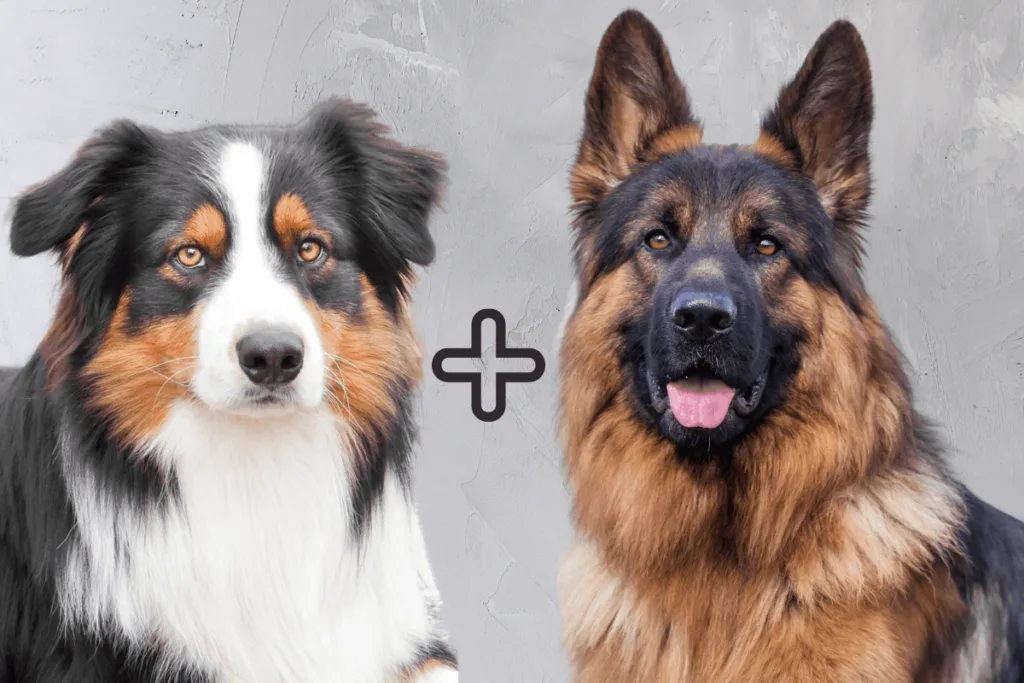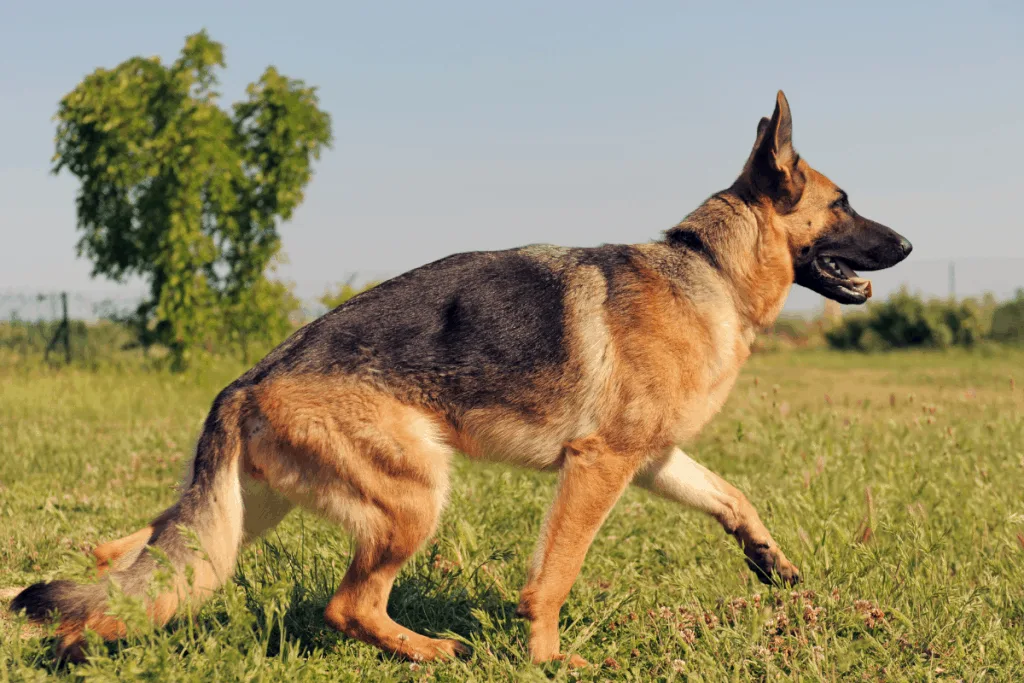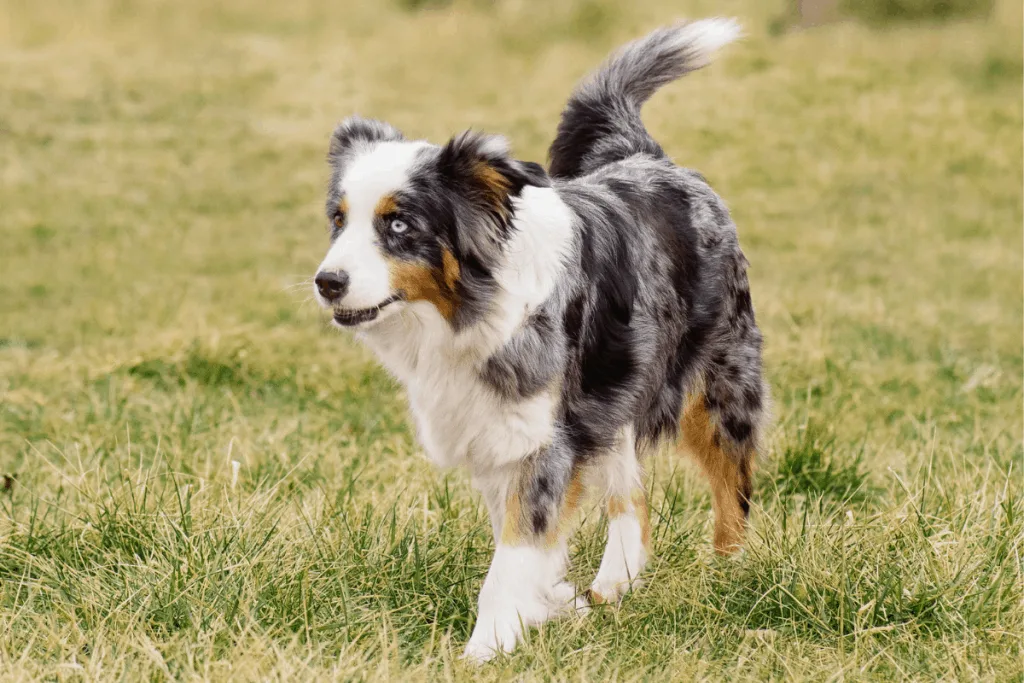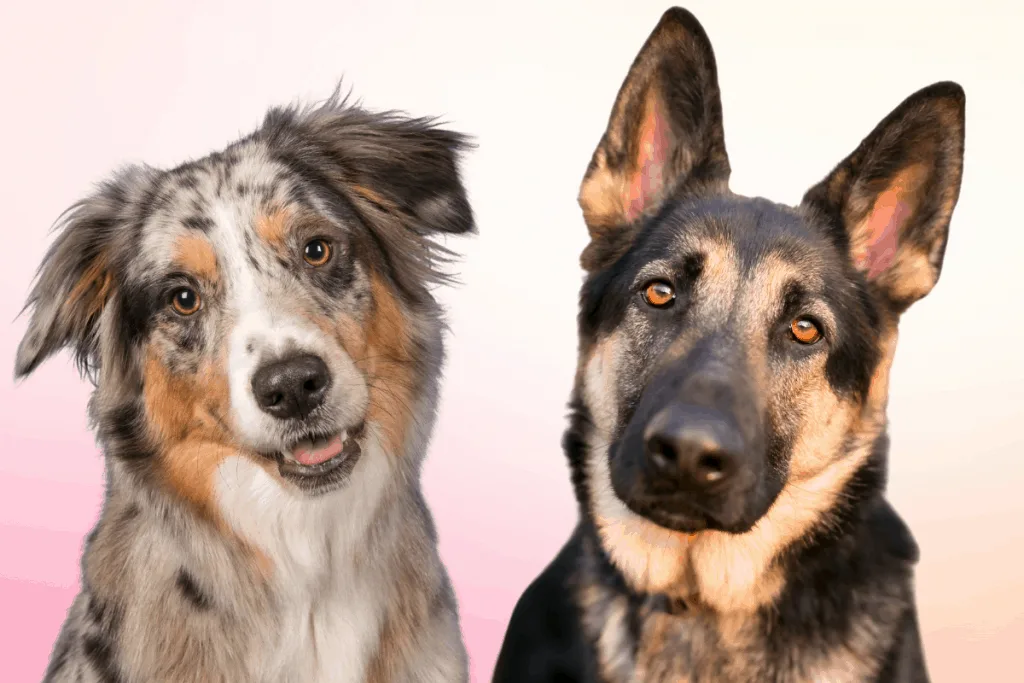
Have you recently found yourself wondering about the German Shepherd Australian Shepherd mix? While this hybridization isn’t its own, fully-recognized breed, it is a popular option among shepherd breeders and fanatics.
The German Shepherd Australian Shepherd mix (also called the German Australian Shepherd) is a hearty and high-energy dog. They are known for their high intelligence and impressive herding ability, though they require extensive time and effort to properly train.
Let’s discover more about this unique mix of German Shepherd and Australian Shepherd to find out just how right this hybrid breed might be for you and your household.
Click Here to Jump to a Section
What Is a German Australian Shepherd?
A German Australian Shepherd is a mix between the German Shepherd breed and the Australian Shepherd breed. It is a relatively rare mix and is typically only available from specialty breeders.
As such, understanding its personality, activity level, and potential health issues can be tricky. Fortunately, this guide can help. If you’ve been wondering if a German Australian Shepherd might be the ideal addition to your home and family, keep on reading!
Is a German Australian Shepherd Right for Me?
Australian Shepherds and German Shepherds are both active breeds. Additionally, both breeds exhibit medium and long fur lengths that require daily brushing and maintenance.
Due to their high energy levels, these breeds may also develop joint-related health conditions in later life.
Determining if a German Australian Shepherd is right for you means taking all of these facts into consideration and applying them to your lifestyle, habits, and pet-care capabilities.
When it comes to the German Australian Shepherd, there are three primary issues to keep in mind. These are:
- Space and Time Limitations
- Current Dog Training Experience
- Long-Term Care Costs
By examining each of these potential hiccups in a little greater detail, you can begin to determine just how right the German Shepherd Australian Shepherd mix might be for you and your household.
Space and Time Limitations
German Australian Shepherds tend to enjoy having plenty of open space to run and play. If you live in a small, high rise apartment building, you may not have the space to keep your pup happy and healthy.
Naturally, if you have plenty of time to take your dog out for walks or playtime at a local dog park, you might be able to get away with owning a German Australian Shepherd while living in a small space.
As such, as a prospective owner, you need to honestly gauge how much time and space you have to offer.
For detailed information about keeping a German Shepherd in an apartment, be sure to check out the article linked below:
Can a German Shepherd Live in an Apartment?
Current Dog Training Experience
Have you ever raised or trained a dog before? If not, now might be the time to start taking training courses or lessons.
While German Australian Shepherds are quite intelligent and respond well to training, you need to be up-to-date with training techniques to enjoy the best results from your training sessions.
Alternatively, you could also choose to enroll your pup in a doggy-training daycare. While this can be somewhat pricey, it’s also a way for hectic pet parents to find relief from naughty puppy habits.
For more on training a German Shepherd, and to give you a better idea of what it takes for this mix, be sure to check out this guide:
German Shepherd Training Guide: All You Need to Know
Long-Term Care Costs
Though mixed breeds can suffer from fewer health conditions than their purebred parents and cousins, that doesn’t mean that they can’t fall ill or develop worrying health problems.
If you’re unable or unwilling to invest the time and money into caring for your dog’s potential health conditions, you may not want to opt for a German Australian Shepherd.
German Shepherd and Australian Shepherd Facts
Now that you’re more familiar with the idea of owning a German Australian Shepherd, you can better appreciate its parent breeds: The German Shepherd and Australian Shepherd.
One of the best ways to understand the German Australian Shepherd is to take a long, hard look at its origins.
As such, we’ve developed these two brief profiles to help get you caught up with the German Shepherd and Australian Shepherd. Enjoy!
German Shepherd Facts

German Shepherds hail from rural areas of Germany. They were originally a mish-mosh of many distinct and localized shepherding breeds, each one belonging to a unique area of what was then the German princedoms.
But as these princedoms unified, so did the idea of a singular, standardized German Shepherd Dog (GSD).
We can thank the efforts of one Max Emil Friedrich von Stephanitz for the creation of this breed, as it was he who registered the very first German Shepherd back in 1899.
The German military utilized these dogs during the World Wars, and German Shepherds are still used by various police forces and militaries around the world today.
German Shepherds live an average of 10 years and can be fiercely loyal and protective of their owners.
They are an active breed that responds well to plenty of exercises and mental stimulation.
The standard coloration of this breed is a combination of dark browns/black and gold/creme. The eyes, ears, mouth, and back of the German Shepherd typically exhibit the darker fur hues.
German Shepherds are fantastically intelligent and can be easily trained. They have a double coat of hair that helps to keep them both cool and warm, so shaving is not advised.
However, daily brushing with a stiff-bristled brush can help pups shed old hairs without too much fuss.
For more on each of the topics about German Shepherds that we’ve just briefly covered, we’ve linked a few detailed articles for you. Each one will provide you with detailed information:
Why Are German Shepherds Good Police Dogs?
How Long Do German Shepherds Live? A Detailed Guide
Grooming a German Shepherd: All You Need to Know
Australian Shepherd Facts

Despite their name, Australian Shepherds don’t hail from Australia. Instead, they were cultivated and bred in the West, namely California.
Their proto-origins can be traced to ancient Spanish pups that were brought to North America by wandering explorers or conquistadors.
Australian Shepherds were bred to have their gorgeous, multicolored coats and brilliant-blue eyes. They were also bred to herd livestock (primarily sheep and young cattle). As such, this breed became extremely popular with active families, especially those with small families.
These dogs have medium-to-long coats the respond well to daily dry brushing.
A great brush that is highly effective on this mix’s coat is the Hertzko Self Cleaning Slicker Brush. This brush is tried and tested, and it will save your dog’s coat from tangles and burrs that are sure to come about due their highly active nature.
Like the German Shepherd, it also has a thick double coat. The Australian Shepherd is considered to be slightly more energetic and anxious than the German Shepherd, and it’s often smaller.
However, Australian Shepherds are equally intelligent and trainable. Due to their high-energy natures, these dogs do well with owners willing to feed them high-protein diets and care for their unexpected health issues as they arise.
What to Expect With the German Shepherd Australian Shepherd Mix
Before you allow yourself to fall head over heels for a German Australian Shepherd pup, you’ll want to take a second and ruminate on these following personality traits often found in German Australian Shepherds.
If you’re looking for a dog with a specific personality, it’s crucial to take the parent breeds into account before choosing a mixed breed.
By considering both German Shepherds’ and Australian Shepherds’ temperaments, you can be sure that their offspring are likely to be intelligent, loyal, and full of energy.
Intelligence
Looking for a super-smart pup that can learn tons of tricks? A German Australian Shepherd might be right for you.
Just remember that active, high-energy nature might kick in during training. Be patient and limit distractions to enjoy a more effective puppy training session.
Loyalty
This mix can be incredibly loyal and protective over its owners. German Shepherds are renowned for their watchdog abilities, and Australian Shepherds are gentle enough to corral livestock into pens.
Hence, their offspring is likely to be just as helpful and alert.
Energy
Both parent breeds of the German Australian Shepherd are wonderfully high energy.
Just take a look at the video below to get an idea of how adorable and energetic this mix can be!
This makes the German Australian Shepherd an excellent companion for hikers, campers, athletes, and anyone else who consistently finds themselves on-the-go and full of energy.
For more on German Shepherds and hiking, check out this informative article linked below:
Do German Shepherds Like to Hike? Tips & Hiking Gear
Health Concerns
Before you leap at the opportunity to acquire a German Australian Shepherd, you’ll want to familiarize yourself with their potential health conditions.
Because this mix comes from two well-known breeds, we can analyze the common health concerns exhibited by German Shepherds and Australian Shepherds to discover what illnesses or medical conditions might affect their offspring.
In general, these parent breeds tend to suffer from conditions like:
- Epilepsy
- Hip Dysplasia
- Cataracts and Eye Disease
- Hemophilia
- Hypothyroidism
- Bloat
- Diabetes
- Deafness
Before you commit to owning a German Australian Shepherd, you’ll want to study up on these ailments.
As you read and research, consider how willing you are to secure and pay for the necessary treatments associated with each condition.
Should you find yourself silently shaking your head and thinking, “That sounds like a lot of trouble,” you may not be well-suited for this active, large, and boisterous mixed breed.
However, if you feel confident that you can handle whatever your future shepherding pup can throw at you, it might be time to start searching for a breeder.
Without further ado, let’s examine some of the most prevalent health concerns found in German Australian Shepherds.
Epilepsy
Both Australian Shepherds and German Shepherds are known to suffer from epilepsy occasionally. This can be quite worrisome for pet owners who have never cared for an epileptic pet.
Unfortunately, unlike many other health conditions found on this list, a German Australian Shepherd can inherit idiopathic epilepsy from both parents.
The chance of a litter containing at least one epileptic pup is far higher in this mix than in others.
Inherited epilepsy is not something that can be tested for, which makes matters slightly more complicated. As such, pet owners may be unaware of their pet’s condition until symptoms arise.
Treatments for canine epilepsy are available, but they’re not 100% effective for all breeds, and they can produce unpleasant side effects.
Hip Dysplasia
German Shepherds are typically large dogs, and Australian Shepherds can be medium or large-sized. As such, their offspring tend to be a hefty, well-muscled lot.
While this extra girth makes them excellent hunters and protectors, it also shortens their life span.
Large breeds often suffer from arthritis and joint conditions. Hip dysplasia, a joint deformity that occurs during a dog’s puppy years, is relatively common among German Shepherds and Australian Shepherds.
This deformity can cause pain and difficulty walking, especially as the dog ages.
Regular exercise and a nutritious diet are thought to be two of the best preventative tips. However, pet owners can also seek surgical options for adult pets that suffer from this condition.
Read all about German Shepherd joint problems in the article below:
German Shepherd Joint Problems: All You Need to Know
Cataracts and Eye Disease
Australian Shepherds, particularly those with light-colored eyes, are prone to developing cataracts, especially as they age.
German Shepherds have much darker eyes, but they can suffer from congenital eye disease.
If you decide to own a German Australian Shepherd, you’ll need to ensure that your veterinarian performs in-depth eye examinations during each visit.
Additionally, you may want to consider supplementing your dog’s diet with foods that promote excellent eye health. Carrots, eggs, and fish are just a few potential options.
Human Foods Safe for German Shepherds: And What to Avoid
Hemophilia
Hemophilia, sometimes spelled haemophilia, is an inherited disease that affects the blood’s clotting ability.
Fortunately, it may not be a considerable issue for German Australian Shepherds, thanks to their mixed bloodline. Still, it is something that new doggie parents should test for.
Hypothyroidism
Australian Shepherds may have beautiful coats and eyes, but those features only came after decades of consistent interbreeding.
As such, Australian Shepherd pups are notoriously prone to a few inherited conditions. Hypothyroidism is one such condition.
Though German Australian Shepherds are slightly less likely to develop this condition than full-blood Aussies, it’s crucial to keep an eye out for signs of dry skin or hair loss as these are both symptoms of hypothyroidism.
Weight gain and sudden changes in behavior may also be indicative of underlying health problems.
Bloat
Bloat is the non-medical term for either Gastric Dilatation and Volvulus (GDV) or Gastric Dilatation (GD).
GDV is often a complication of GD, so dogs with apparent signs of bloat should receive immediate medical care to prevent GDV. Some of the earliest signs of bloat include:
- A swollen abdomen
- Retching without vomiting
- Excess salivation
- Yipping or pained cries when pressure is applied to the stomach
GD occurs when excess gas builds up in the stomach. GDV is when the stomach experiences torsion as a result of that built-up gas.
Neither condition is comfortable for your dog. Sadly, the exact cause behind bloat isn’t entirely known. However, a poor diet may be a likely culprit.
We cannot stress the importance of watching out for this condition, because if it is left untreated, it can be fatal to a dog.
Diabetes
Diabetes is most often the result of a poor or low-nutrient diet. Pet owners can help prevent this condition by providing fresh, nutrient-rich foods full of protein, healthy fats, vitamins, and minerals.
Store-bought kibble is often full of crude fats and empty carbs, making it a lackluster option.
If you’re determined to provide the best care to your German Australian Shepherd, you’ll want to prepare meals either daily or weekly.
Fortunately, a food processor and a few freezer-friendly containers can make short work of your pup’s meal prep. You can even serve many meals frozen, especially during the summer.
If you would like to know more about feeding your dog a well-rounded and holistic diet, be sure to check out the article below. It will take all of the guesswork out of the equation for you:
Feeding Your German Shepherd a Holistic Diet: What You Need to Know
Deafness
Australian Shepherds are known to suffer from congenital deafness occasionally.
However, this is often the result of two light-colored Australian Shepherds breeding and may not affect German Australian Shepherds due to their mixed ancestry.
Trainability

Training a German Australian Shepherd should be (relatively) easy work. Both parent breeds are known for their high intelligence and quick wit, and both strive for positive reinforcement from owners.
Still, if you haven’t undergone basic dog training classes, you may need to train yourself before attempting to train a pup.
While the German Australian Shepherd learns commands rather quickly, it’s also a high-energy breed that will demand a LOT of your time and attention while training.
German Australian Shepherds can become easily distracted, leading to a frustrating training session for all parties involved.
To avoid this outcome, it may be a good idea to isolate yourself and your dog away from other animals, people, or distractions when attempting to teach commands.
This way, your German Australian Shepherd will be able to give you its undivided attention.
As long as you remember to bring treats with you (and you should; they’re a very effective form of positive reinforcement), you shouldn’t have any problem teaching your pup to sit, stay, shake, and rollover.
Practice makes perfect when it comes to training a dog. You’ll need to repeat commands and training rituals often to ingrain them as habits.
Additionally, it may help to utilize clicker training. Lastly, remember to be patient with your German Australian Shepherd, especially when they’re young.
High-energy breeds like this one tend to take on life with a constant sense of “oh my goodness, wow” that never ceases. If you’re a low-energy person, this breed might not be the right one for you.
Temperament
Both German Shepherds and Australian Shepherds are protective and loyal breeds. They’re also both known for their astounding level of intelligence and high activity level.
However, their personalities do differ in a few crucial ways.
While German Shepherds can be quite playful, especially when they’re puppies, they tend to mellow out and become laid-back adults.
On the other hand, Australian Shepherds tend to stay spunky, energetic, and incredibly playful for most of their lives.
Australian Shepherds may also be more prone to showing affection than their German counterparts. As such, the Australian German Shepherd is often energetic, loyal, intelligent, protective, and relatively affectionate.
Still, precise temperament is bound to vary somewhat from pup to pup. Some German Australian Shepherds may be wonderfully loving and desire near-constant attention from their owners. Others may be more aloof but still highly protective.
Nutritional Requirements
German Australian Shepherds are typically medium or large-sized dogs. As such, they require more food than smaller breeds.
Due to their large bones and hefty bodies, their diets should consist of plenty of proteins and nutrients.
Whole foods that are naturally protein-rich tend to be an excellent option for German Australian Shepherds. Various meats, fish, vegetables, grains, and fruits can ensure that your pup is getting all of the vitamins and minerals it needs to grow up strong and fit.
As always, be sure to avoid foods that can prove toxic to canines. Common examples include onions, leeks, chives, chocolate, avocado, and raisins. Try to stick to oats, poultry, gently cooked meats, and tons of leafy greens and beans.
Exercise Requirements
Both German Shepherds and Australian Shepherds are active breeds. As such, it makes sense that the German Australian Shepherd would be just as excitable, ready to play, and full of energy.
To keep your German Australian Shepherd in excellent shape, you’ll need to invest at least two solid hours to playtime and exercise each day. If you can spend another hour or two helping your pup get rid of pent-up energy, even better.
After all, Australian Shepherds are considered one of the most active dog breeds in the world. They’re built for constant action, so keeping them in a small, lonesome apartment is only likely to result in chewed-up shoes and lonely howls.
The German Australian Shepherd may attempt to manage their energy levels and anxiety via negative behaviors, so proper exercise and training is crucial.
Cost
German Australian Shepherds are unique dogs. They’re bred from purebred Australian Shepherds and German Shepherds, so they’re typically only available through breeders specializing in those breeds.
Because German Australian Shepherds are considered designer dogs, the cost of purchasing one is bound to vary. However, costs are typically fairly high.
In some cases, you may need to adopt breeding parents to acquire a German Australian Shepherd.
The cost of each breeding parent ranges between about $600 and $1000. As such, a German Australian Shepherd is likely to cost anywhere between $1000 and $2000. When you also consider healthcare costs, this initial sum begins to inflate.
That’s because German Australian Shepherds are prone to specific health conditions, including hip dysplasia, elbow dysplasia, and cataracts.
A single pup is likely to cost owners about $1,500 per year in regular veterinary visits, food, and toys.
Because German Australian Shepherds tend to live to about 13 years of age, the total cost of care comes out to about $21,000.
To give you a better idea of the costs involved in raising a German Shepherd puppy, be sure to read the informative article linked below:
How Much Does a German Shepherd Puppy Cost?
Final Thoughts
German Shepherds and Australian Shepherds are both beloved dog breeds that are prized for their intelligence, loyalty, and strength.
The German Shepherd Australian Shepherd mix may not be an officially-recognized breed, but it is an exceptional dog.
German Australian Shepherds are designer dogs typically only available from specialty breeders. They require tons of room to play, run, and move as they’re a high-energy breed.
This mix also needs to eat a diet that is rich in protein and nutrients, especially those that could help prevent some of its most common health conditions.
If you have the time, energy, and funds to acquire one of these magnificent pups, then you shouldn’t hesitate to close the deal.
However, if you’re someone who enjoys taking it easy after work and spending plenty of time alone, a German Australian Shepherd may not be the right dog for you.

